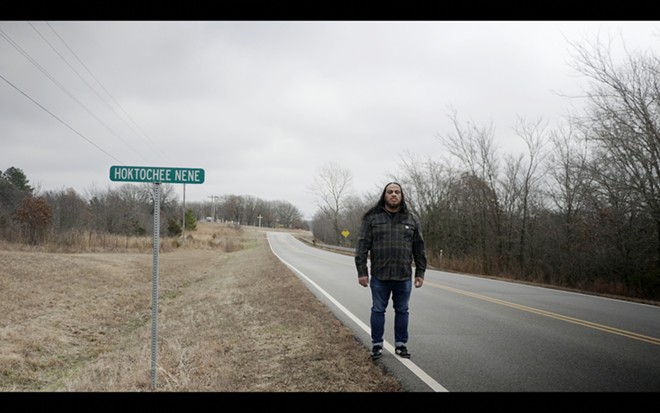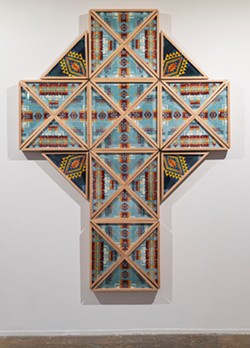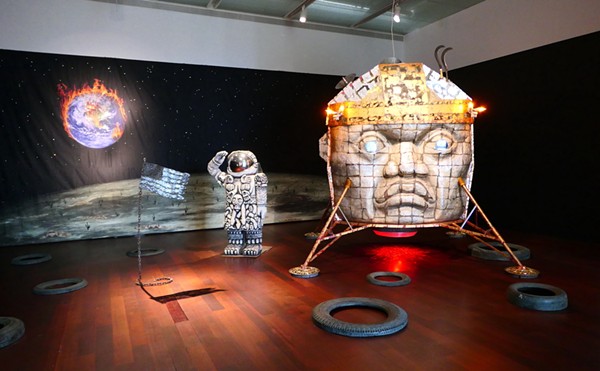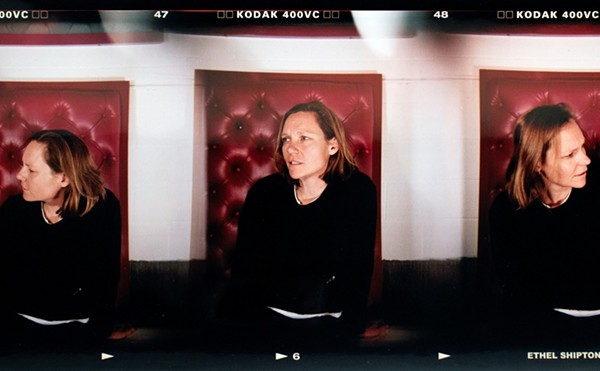
My computer ain't woke.
It underlines words like "placelessness" in angry red squiggles and phrases such as "culture of erasure" in double blue lines, indicating that I made a grammatical error or that something is missing. It's not wrong. Something is missing: roughly 25 million people.
San Antonio-based artist Joe Harjo's work is underscored by the cognitive and emotional awareness of the genocide of an untold number of human beings — the obliteration of the hundreds of distinct nations and cultures that existed before our own on the same soil we now call the Americas.
His work includes multiple ongoing series that ruminate on this weight, a state that makes the act of merely breathing not just self-deprecating but audacious. Within every inhale and exhale resides a simple battle cry— to some an affront or ineffectual statement and to others an au fait whisper — "I'm still here."
Harjo is a tribal member of the Muscogee (Creek) Nation of Oklahoma. Born in Oklahoma City, he attended the University of Texas at San Antonio for his Master of Fine Arts degree, which brought him to our town in 2009.
A multidisciplinary artist, Harjo allows his medium to vary according to concept, and he often uses humor to tackle tough subjects like Native American identity and representation, cultural erasure and the ignorance bred by stereotypes.
Ironically, his practice is currently placeless. He lost his space at the Southwest School when it merged with UTSA.
"The Southwest School was about makers breeding makers," Harjo said. "Without my own space — although I do still have access to all the campus' facilities — I have to work where it is convenient."
Most recently, that was UTSA's old satellite space at Blue Star, which he used to create his current exhibition at The Contemporary at Blue Star, "Joe Harjo: Indian Removal Act II: And She Was."
"The title of this body of work derives from the Indian Removal Act of 1830, which forcibly displaced Native nations — including my own, the Muscogee nation — to 'unsettled' lands west of the Mississippi River," Harjo wrote in his artist's statement. "Through addressing the current misrepresentations, homogenization and undervaluation of Native culture, the work brings visibility to and emphasizes Native growth, contributions, resourcefulness, adaptability and our existence within contemporary spaces."
In this instance, Harjo is highlighting the forced break from a historically matrilineal culture to an enforced Christian patriarchy.
Harjo's great-great-great-great-grandmother was among the Muscogee forcibly removed from their ancestral lands and ordered to march to a reservation in Oklahoma, a travesty known as the "Trail of Tears" in history books. Native people refer to the event as "The Long Walk," and an estimated one-fourth of those forcibly relocated people died along the way.
Upon arrival at the reservation, Harjo's orphaned great-great-great-great-grandmother's identity was recorded simply as "baby girl" instead of her given name "Hocktochee," because she was not yet able to spell in English and U.S. officials didn't consider the Muscogee language legitimate. Hocktochee was known to her family by the nickname Babygirl, and her presence in the exhibition space is palpable.
I had the pleasure of watching Harjo work when he conceived and installed The Only Certain Way at Sala Diaz in 2019, a space I curated for several years. The exhibition was a collection of works that spoke to the forced assimilation of Indigenous Peoples to Christianity through the lens of Spanish explorer and conqueror Álvar Núñez Cabeza de Vaca.
Cabeza de Vaca kept a journal of his experiences as the leader of the first European entourage to set foot in the American Southwest after crashing his galleon near modern-day Galveston. In reference to religious conversion and assimilation, he wrote in his journal that Indians "must be won by kindness, the only certain way." Kindness was inexplicably weaponized — a tool used to shift belief systems.
To do so effectively, Cabeza de Vaca adopted practices associated with Native religious ceremonies, becoming a sort of twisted shaman performing healing breath rituals and passing out blankets infected with European pestilence along his path.
The works included in The Only Certain Way uncovered the lack of visibility of Native American culture, identity and lived experience. The complex and undeniable relationship between Native and U.S. histories exposes the ways in which tribal identity has been dismantled and homogenized to strip vast communities of their spiritual practices and traditions. Forced colonization and assimilation to Christianity led to the whitewashing of Native cultures and customs, thereby removing access to ancestors and the comfort of their omnipresence.
Several of Harjo's series, including his "performance prints" — graphic red acrylic-ink footprints or sneaker treads on white backgrounds accompanied by evocative language — carry on from exhibition to exhibition. The subject matter shifts according to what the artist is ruminating on at present.
"This series began in 2012. I was thinking about what people envision when they hear the word 'Indian.' I mean, do people picture someone doing mundane tasks while wearing a ceremonial headdress?"
The series began as such. "Indian watching porn, Indian checking Facebook," he said with a laugh. "I was invested in that absurdity."
By 2018, it evolved significantly.
"I was really bothered by the lack of attention paid to the loss of life in Black communities at the hands of the police, including apathy in Native communities," Harjo said.
Indian holding a weapon (Skittles), Indian holding a weapon (license) and Indian holding a weapon (loosey) are all from that period. They refer to the murders of Trayvon Martin, Philando Castile and Eric Garner, respectively.
And She Was contains a group of six performance prints that reference The Long Walk, including the two pieces Removed from familiar wind, deafened and Removed from fertile land, starving. Indian holding a weapon (breath) accompanies a video of a conversational text between two women on The Long Walk. Behind it is a massive installation of backlit red stripes excised from the American flag that hang from ceiling to floor. The conversation starts off with the two women passing time as they endure their 1,200-mile journey. They come across a body. One of them notices movement and they approach the corpse finding a baby in its arms. They pick up the child, a girl, and soothe and comfort her as best they can.
"Hello, baby girl."
Harjo also continues his use of Pendleton products set in handmade triangular frames that mimic memorial flag cases used by families of service people killed in action as keepsakes. Pendleton, a business established during the 1860s in the Pacific Northwest, mined Native motifs for its high-quality woolen blankets and sold them at top dollar. This practice is problematic on many levels.
First, referring back to Cabeza de Vaca and his ilk, blankets are now known to be a major carrier of disease, be it influenza, the common cold or smallpox — deadly diseases for which the Native population had no immunity and that became a major source of devastation.

Secondly, Native motifs aren't just design elements. Some pieces document creation myths while others tell the stories of epic battles or detail the lives of tribal elders. Each is a codex, traditionally woven by women. Native history wasn't just appropriated in this case. It was corrupted and monetized.
Pendleton once claimed a 9,000-year history, co-opting Indigenous practices that predated the company by thousands of years. The blankets eventually became status symbols — heirlooms handed down generation to generation, mostly among the white population of the Pacific Northwest.
To make matters more complicated, those same blankets now hold high status in Native communities, where they're given as gifts to commemorate births, weddings, graduations and other rites of passage.
"I've always wanted to use Pendleton blankets in my work, but they are insanely expensive," Harjo said. "The flag cases sold in stores are also ridiculously priced."
During Harjo's 2018 residency at the Vermont Studio Center, he came across a suitable substitute: Pendleton beach towels. He then had to tackle the task of making cases to the exacting measurements of flag memorial cases. His first iteration was two crosses, one made with brightly colored textiles, the other entirely devoid of color. They hung back-to-back on the wall that divides the space of Sala Diaz — one in the front room, one in the second. Together, the work references and memorializes the whitewashing of Indigenous culture.
In his statement, Harjo says the two Pendleton works in "And She Was" symbolize the duality of colonialism: religious iconography and its apparatus of violence. He urges viewers to critically reflect on the true nature of colonial encounters.
During our walkthrough of his exhibition at The Contemporary, we had our own encounter of sorts, meeting two lovely young women who are currently students at the San Antonio campus of Texas A&M.
One asked Harjo about his tribal name. He explained that prior to colonialism, his name would have been earned on the battlefield and given to him through his matrilineal line. Harjo, which roughly translates to "crazy brave in battle," is now like any other Christian surname.
The other young woman, a poet, handed Harjo her notebook and asked for his autograph. Visibly uncomfortable, he accepted nonetheless, stating that that this was the first time anyone had ever asked. He took her notebook and pink pen. I saw him draw a rather fey heart and turned away.
The rest is between him and baby girl.
"Joe Harjo: Indian Removal Act II: And She Was," Free, Noon-5 p.m. Wednesday, noon-8 p.m. Thursday and Friday, 10 a.m.-6 p.m. Saturday and Sunday through May 5, The Contemporary at Blue Star, 116 Blue Star, (210) 227-2960, contemporarysa.org.
Subscribe to SA Current newsletters.
Follow us: Apple News | Google News | NewsBreak | Reddit | Instagram | Facebook | Twitter| Or sign up for our RSS Feed

















